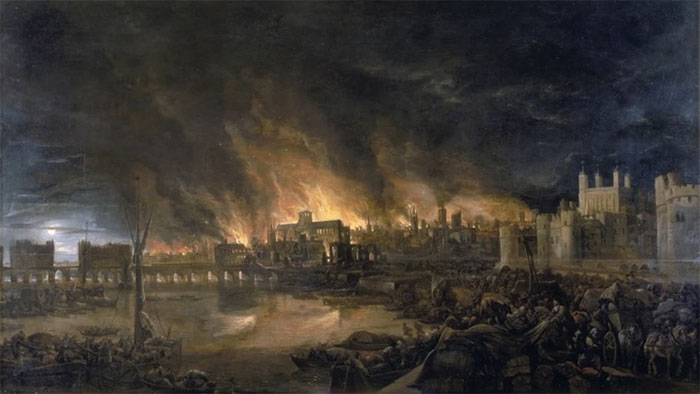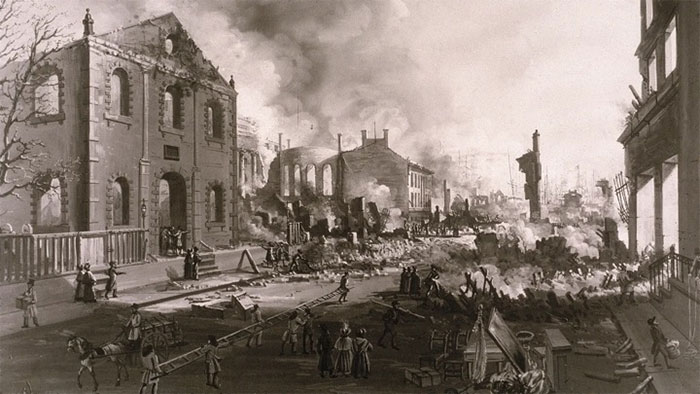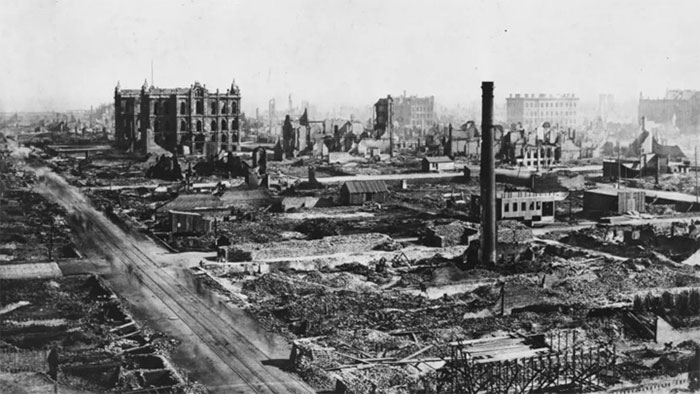Throughout human history, many fires have occurred, causing changes in the distribution of population, infrastructure and the course of events around the world.
Fires change the world
1. The fire of the Great Library of Alexandria
The fire that burned this great library is still controversial.
The Great Library of Alexandria is part of the Mouseion (Temple of the Muses) in Alexandria. Inside there is a wealth of immeasurable value: knowledge of the ancient world, stored in half a million rolls of paper collected in Assyria, Greece, Persia, Egypt and India. Academics from all over the world flock here to study and work, including Euclid and Ptolemy. The library was built under Ptolemy I Soter, a general of Alexander the Great and the founder of the Egyptian Ptolemaic dynasty, in 283 BC.
closed the city in 48 BC. Most scholars believe that a library branch was fortunate enough to be at peace in the Serapeum temple, but was later destroyed in 391 BC by Theophilus, the bishop of Alexandria, and the Christians. from him, who would later build a church in the ruins of the library. No matter who acts, the priceless scrolls containing ancient knowledge are no longer in this world.
2. Great Fire of London

This great fire left 100,000 people homeless.
The California Forest Fire in 2020 was not the first major fire to occur amid a pandemic; The Great Fire of London devastated the burning city at the height of the Black Death pandemic and destroyed more than 13,000 homes, leaving 100,000 people homeless. From September 2-6, 1666, a fire destroyed much of medieval London and damaged many iconic structures such as St. Mary’s Church. Paul. People fled, trying to bring in as many properties as possible, creating chaos on the streets and highways.
The reconstruction of London took more than 30 years, but Sir Christopher Wren’s town plan can still be seen today, through stone structures and spacious streets, which have replaced for narrow lanes and structures in wood that the fire “ate”. The London fire also formed two completely new industries: modern property insurance and fire.
3. The Great Fire of New York

On a bitter winter night, on December 16, 1835, a warehouse in the central area caught fire.
The great fire of 1835 took place in the midst of a cholera epidemic in New York City. On a bitter winter night, December 16, 1835, a warehouse in the central area caught fire. Strong winds quickly spread the fire, hitting more than 17 neighborhoods and turning an ice-covered part of the East River into a sea of flames as pine oil from the warehouse spilled into the water.
The city’s water supply system at that time was not strong enough to contain the blaze. New York’s population has grown by 60% over the past decade thanks to a boom in trade along the Erie Canal and weak systems to protect public health and drinking water.
From their ashes, the people have shown their ability to improve themselves: they built the Croton Water Bridge in May 1837. “It supplies the city with 12 million gallons of water a day, gives the firefighters what they get. need to put out fires and a source of clean water for homes and businesses – which is especially critical for a city facing a persistent pandemic, “said Dan Levy, author of the upcoming Manhattan Phoenix book.” He has revolutionized the American water system and became a model for a whole generation of American engineers who later contributed to the countless train piers that guide the water and the many canals of the land.
4. Great Chicago Fire

The fire left 300 people dead and over 90,000 homeless, and a third of the city was destroyed.
The Great Chicago Fire took place from October 8 to October 1871, killing 300 people and leaving more than 90,000 homeless, a third of the city damaged. “Since Chicago was the center of the national telegraph network with links to Europe, this great fire became the premier international live news event,” said Carl S. Smith, author. Chicago’s Great Fire: The Destruction and Resurrection of an Iconic American City.
The “great reconstruction” that took place after the fire helped change the face of Chicago, turning it into a new and powerful economic center. Over $ 10 million has been donated to the community. “It was all done quickly with a huge amount of money,” Smith said, “because Chicago’s crucial position is between the natural resources of the American outback and where the food is produced. favored by Eastern and Eastern Europeans – grains, meat and many other products and items – its reconstruction is therefore a top priority and an investment that resonates with investors. The great fire had a great impact on the image of Chicago, the epitome of the irresistible modern life in America ”
5. The Shirtwaist Triangle Factory Fire
The Triangle Shirtwaist factory fire on March 25, 1911 killed 146 Triangle Waist Company workers, who were trapped in the Asch building in Greenwich Village, New York. Many people perished trying to jump out of the building in the first two and three, or were burned to death in the crowd because they could not escape the locked exits. “Everyone trying to jump was dead. It was a horrible sight” – said witness Frances Perkins. Most of the victims are young women and immigrants, many of whom have come to America in the hope of having a better life.
The fire helped unions and public criticism prompted the US government to take action to protect workers, leading to the emergence of government departments. New law on occupational safety. Perkins was so angry that he dedicated his life to protecting the interests of workers. She helped set up the Factory Investigation Committee and eventually became Secretary of Labor for the Franklin D. Roosevelt Administration, making changes to the work environment across the United States.
6. The Reichstag fire
 Firefighters turned the Reichstag, the German parliament building, into a sea of flames on February 27, 1933. Adolf Hitler, a rising politician who had been appointed Nazi Prime Minister a month earlier, immediately accused the Communists of ’cause the fire.
Firefighters turned the Reichstag, the German parliament building, into a sea of flames on February 27, 1933. Adolf Hitler, a rising politician who had been appointed Nazi Prime Minister a month earlier, immediately accused the Communists of ’cause the fire.
“The burning of the Reichstag played an important role in consolidating Hitler’s power,” said Benjamin Hett, professor and author of Burning the Reichstag. “He provided an excuse for an emergency law – also known as the Reichstag Fire Ordinance – that undermined and ended the democratic constitution of the Weimar Republic (the German Republic). freedom of expression and assembly, the right to confidentiality of correspondence and the right not to be arrested without charge.
A little-known, but hugely important decree allows Hitler’s Nazi government to control the government of any German state that does not obey the order. Some state governments at that time were in the hands of evil fascist adversaries, so this power was very important, ”says Hett. controversial issues.
7. Cuyahoga River fire in Cleveland
John D. Rockefeller’s first refinery was built along a creek that flows into the Cuyahoga River. Although the Rockefeller Standard Oil Plant left oil in the river, it was in fact long considered a Cleveland sewer. From 1868 to 1952, this river caught fire 9 times.
The fire we are talking about here, which occurred on June 22, 1969, is quite small compared to the previous ones, but there is one essential difference: “Many rivers were badly polluted in the 1960s, but the Cuyahoga River caught fire as the national media began to view pollution as a serious problem and society became increasingly aware of the need to protect the environment ”- in the words of John H. Hartig, Ph.D ., policy consultant – science in the Great Lakes region.
“The Cuyahoga fire and other environmental disasters such as the Santa Barbara oil spill in 1969 have become national symbols of industrial indifference and poor public regulation. needs a goal to focus on, and the Cuyahoga River fire becomes the number one contender, ”Hartig said. Time magazine covered the Cuyahoga River fire in the same issue as the lunar landing event and Ted Kennedy’s Chappaquiddick scandal, bringing the story to 8 million readers.
The public response to the Cuyahoga River fire in 1969 led to the establishment of the Environmental Protection Agency and environmental protection laws such as the National Environmental Policy Act 1970, the Clean Water Act. 1972, the 1972 Great Lakes Water Quality Agreement between Canada and the United States and the Endangered Species Act 193.


